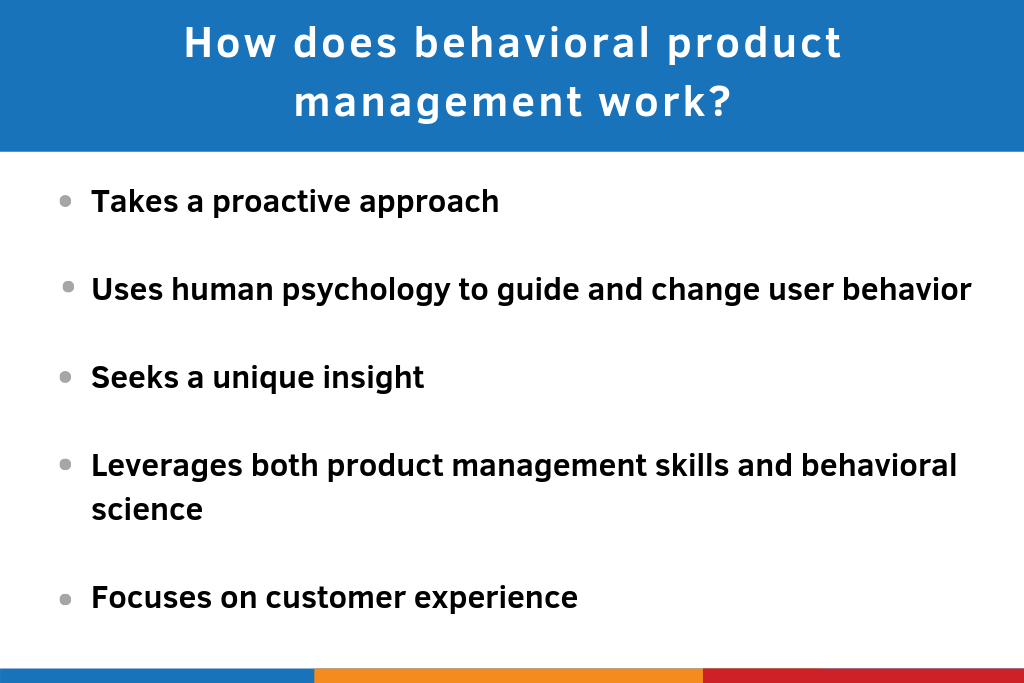What is Behavioral Product Management?
Behavioral product management applies behavioral science and human psychology to product design.
When planning their products, behavioral product managers take into account that people make irrational decisions. Keeping this in mind, they apply psychological research to build products around those irrationalities. The approach also uses psychological principles to guide customers to the behaviors that the PMs wish them to take.
How Does Behavioral Product Management Work?
It’s a logical outgrowth of traditional product management. All PMs try to create successful products based on their understanding of what motivates customers: their needs, desires, hopes, fears, and frustrations.
However, behavioral product managers understand that the most popular method of learning this information—through customer feedback—can lead to inaccurate conclusions. This is because humans are irrational beings. We don’t always know our reasons for acting or believing a certain way. The context of a situation can alter our opinions.

Because they understand the limits of users’ self-reporting, behavioral PMs rely less on what they learn in customer interviews. Instead, they take a more proactive approach, based on what they know about human psychology to guide and even change their users’ behaviors.
Behavioral PMs have a unique insight into their users and how to build products that resonate.
Because this approach leverages both product management skills and behavioral science, behavioral product management can help an organization create more satisfying customer experiences.
How Does Behavioral Analytics Differ from Other Business Data?
Product teams gather many types of information about their user personas by posing questions to representatives of those persona groups. Surveys, focus groups, customer interviews—these methods can all add value and insights.
But when asking focus group members what feature they’d use most often, a product team might receive a completely different answer than if they instead monitored those people interacting with a prototype of the product.
Behavioral analytics differs from these types of data in that it represents not what people say but what they do.
As we wrote in a ProductPlan blog about the drawbacks of customer feedback, relying on customers’ self-reporting can lead to inaccurate conclusions. One real-world example we cited was a hilarious survey the commercial airlines conducted every few years. They asked passengers the following question:
If you could choose one in-flight snack, would you prefer a healthy option, such as a plate of fruit, or a piece of cake?
As we summarized in the blog: “In survey after survey, the passengers overwhelmingly say they’d rather have the fruit. But when flight attendants roll a real cart down a real aisle on a real flight, an overwhelming majority of passengers ask for the cake.”
Behavioral analytics can be invaluable for uncovering truths about your products’ customers—truths they might not even realize themselves.
What Types of Behavioral Analytics Do Product Managers Use?
Product managers can gain valuable insights by analyzing a wide range of user behaviors within their products. We’ll list a couple of common examples below and explain why they can be useful in helping you refine and improve your products.
The user’s journey through your product
Your company’s product and development teams will have an idea about how best to set up your product’s interface. When asking your customers to view and comment on the intuitiveness of that interface, you might find they have different ideas about how to make it more user-friendly.
But even those ideas might not reflect how your users will navigate the product when they start using it every day.
Monitoring and analyzing how users move through your product is one valuable set of behavioral analytics.
Sticking points in your product
What if your product has some confusing user paths? What if many users become confused and frustrated trying to complete a standard task in your app?
You can’t rely on users sending in comments or calling your Customer Success department because they’re having trouble navigating the product. Many might simply give up. They’ll abandon your app and find another way to solve their problem. Eventually, your company will lose that customer’s business.
It is a smart plan to monitor your product’s usage for common areas where users stop and leave the product. Those could represent sticking points in your app—which you might discover only by monitoring these behavioral analytics.
Examples of Behavioral Product Management
Psychological pricing
Pricing psychology research has found that when customers choose between two pricing options of a product side-by-side, that product’s overall sales increase. Some customers perceive they are getting a bargain by choosing the lower-priced version. Others understand additional value or prestige from choosing the more expensive option. For more on product pricing, read How to Price a Product in 5 Steps.
Decision automation
Behavioral psychology tells us that people find it frustrating to repeat mundane tasks. Behavioral product managers can use this knowledge to make their products more appealing to users. One typical example is the “Stay logged in” option on many apps.
Rather than forcing the user to sign in for each session, the app removes that task and lets the user start using the product immediately.
Simplifying the user’s journey
Human psychology also teaches us people can feel overwhelmed by too many choices.
Armed with this knowledge, behavioral PMs give their users fewer options during each stage of the product’s interface. For example, a software app will offer a collapsed toolbar on its home page, with only the most commonly used actions accessible. This has the psychological benefit of making the user’s encounter with the product calm and welcoming, rather than overwhelming.


